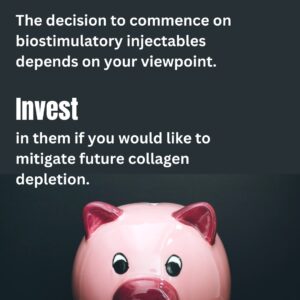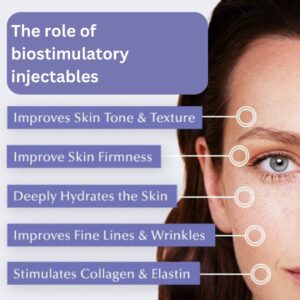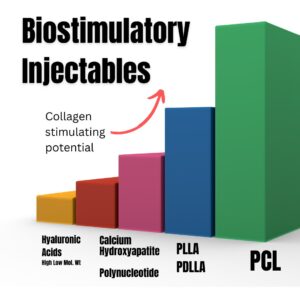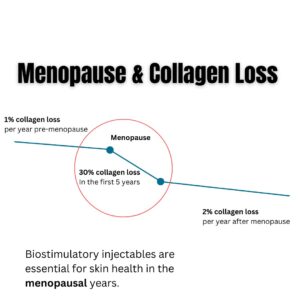Biostimulation refers to a technique that activates the immune system to generate collagen. Injectables are used to awaken fibroblasts, which are cells responsible for producing collagen, thereby preventing additional collagen depletion. Biostimulators can be seen as agents that combat facial aging. It’s important to note that these injectables differ from treatments, which address volume loss in the face.
Biostimulator Injections summarised
- This term refers to the stimulation of cells that produce collagen
- Injectable provide low levels of biostimulation, in turn reducing future age-related collagen degradation
- The type of collagen stimulating injectable depend on factors such as the degree of dermal hydration, background sun damage, volume loss & age
- Biostimulation is important around perimenopausal as collagen loss accelerates around this time (about 30% reduction in 5 years)
What are biostimulators?
Biostimulators, a group of injectables, represent a groundbreaking advancement in the field of anti-aging medicine. These injectables stimulate the production of collagen and elastin by activating fibroblast cells, effectively slowing down the aging process. Consider biostimulatory injectables as proactive treatments.
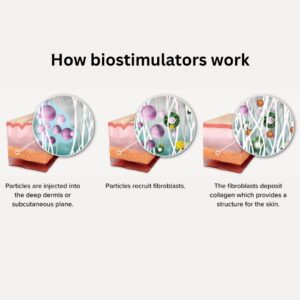
To illustrate this concept further, let’s draw a comparison to visiting a dentist. When patients go to see a dentist, they typically have two main reasons for their visit.
- The first reason is to treat a specific symptom, such as relieving toothache. In dermatology terms, this would be equivalent to seeking correction for volume loss or wrinkles. Just as dentists use drilling or extraction techniques to address tooth issues, I utilize injections to correct age-related volume deficits or recommend laser treatments for wrinkle removal and skin tightening.
- The second reason people visit dentists is for prevention purposes. Dentists perform cleanings and scaling procedures while also encouraging good oral hygiene practices like flossing and brushing with fluoride toothpaste. This preventive approach helps reduce the likelihood of decay and minimizes the need for symptomatic treatment in the future. In my line of work, biostimulatory injectables serve a similar purpose — they aim to delay the onset of symptoms related to volume loss, collagen depletion, and aging.
By utilizing these preventive measures through biostimulation therapies early on in your skincare routine or anti-aging regimen can help extend the time before more invasive corrective treatments become necessary.
Why invest in biostimulators?
Consider these injectables as a proactive measure. They serve as the second line of defense against aging, following skincare practices like using antioxidants and sunscreen. Employing treatments, anti-wrinkle injections, lasers, and energy devices in the right manner can effectively counteract signs of aging. Meanwhile, biostimulators help to decelerate the aging process. It is essential to prioritize prevention before resorting to treatment methods.
What results can you expect?
Disregard, for the time being, the marketing efforts made by parent companies to promote these injectables. The true purpose of biostimulators is to sustain the viability and activity of your collagen-producing cells as you age.
The primary objectives are: minimizing the loss of collagen which leads to wrinkles, sagging skin, and decreased elasticity. Therefore, in its true essence, these injectables are used to slow down the aging process. For individuals in their later years, maintaining tissue hydration becomes crucial. We will delve into this topic more extensively shortly.
The secondary benefit is stimulating collagen production at varying levels in order to achieve measurable improvements in skin tightness and firmness. Some patients even experience a reversal of aging effects such as reduced wrinkles and lifted areas like the lower face and neck region. The extent of skin tightening primarily depends on your immune system’s response and its ability to produce sufficient amounts of collagen.
The tertiary outcomes involve enhancing overall skin quality by improving texture, reducing fine lines, and shrinking pore size.
What is the evidence supporting biostimulatory injectables?
Bioremodelling agents such as collagen stimulators have a robust body of evidence that covers over a decade of research. Australia has been slow on the uptake of these injectables. The first dedicated biostimulatory injectable was only introduced in 2022.
Download these papers to understand more about biostimulatory injectables:
Collagen stimulating injectables
Polycaprolactone_collagen stimulator
How do they differ from treatments?
treatments provide volume, biostimulators are designed to stimulate collagen with minimal changes to volume. In most cases volume refers to correction of fat & bone atrophy, which occurs with age. Biostimulators are aimed at the upper layers of skin.
| Type of injectable | treatment | Biostimulatory injections |
| Volume replacement | Marked. | Minimal. |
| Level of action | Bone & fat > dermal | Dermal layer |
| Collagen stimulation | Minimal | Moderate to marked |
Exceptions apply, as there are treatments that can have both volume replacement as well as biostimulatory actions, depending on the properties & dilution of the liquid. It’s complex.
What types of biostimulators are there?
Two main types of biostimulators, hyaluronic acid based & non-HA based.
- HA based: High and low molecular weight, non-cross linked. Like this one.
- Non-HA based: PLLA, PDLLA, PCL, Polynucleotide, CAH
Hyaluronic acid based biostimulators provide better tissue hydration with some aspects of collagen stimulation. Non-HA based compounds provide better collagen stimulation with minor to modest volume changes (based upon dilution). They do not hydrate skin as well as hyaluronic acid based injectables.
*Hence for patients in their 40s, the best combination includes both HA & non-HA based injectables.
What is the biostimulator of choice for my skin?
Our expertise lies in skillfully navigating complex algorithms to identify and select optimal biostimulators for your specific skin type. During this process, I take numerous factors into consideration including age, facial volume analysis results as well as quality assessment of your skin condition which includes degree of background sun damage along with dermal hydration levels evaluation on top of identifying target areas that require special attention – all while aligning everything with your personal expectations for maximum effectiveness and satisfaction. A rule:
- Late 20s: Non-HA based biostimulators
- 30s-40s: HA based & non-HA based
- 40s-50s: HA based & non-HA volume replacing injectables
- 50s & beyond: HA based & non-HA volume replacing injectables
For a greater understanding of selection, read more.
What is the treatment like?
There are two methods to deliver injectables, needle & cannula. Both methods take between 1-2 minutes to perform. The choice depends on the type & location of the injectable used.
What is recovery like?
Recovery depends on the injectable used & ranges from zero days recovery to 48 hours.
- PLLA or calcium hydroxyapatite biostimulator: no recovery
- Hyaluronic acid biostimulator: 6-hour recovery
- PCL biostimulator: 1–2-day recovery
- Polynucleotide: 48-hour recovery
When will I see results?
The outcomes of the treatment can be seen within one to two weeks in individuals who have dehydrated skin, as the biostimulators made from hyaluronic acid promptly replenish moisture in the deeper layers of the skin. However, it may take up to six months for the skin to become firmer and tighter since new collagen production requires time for regeneration.
It is important to note that bio remodelling agents primarily work towards preventing age-related depletion of collagen. Mitigation, by its very definition, refers to results that are not immediately visible.
How many treatments will I require?
2-4 depending on your level of collagen loss & dermal hydration. As a guide-
30s to mid 40s: 2 sessions
40s to mid 50s: 3 sessions
50s to 60s & beyond: 3-4 sessions
The exact number of sessions depends on two main factors- the degree of collagen loss & your ability to generate new collagen.
How often will I require biostimulatory injectables?
It depends on your age, expectations & degree of skin aging. As a guide, after the first year-
- HA biostimulators: 1-2 times annually
- Non-HA biostimulators: 1-2 times per year
The older you get, the more frequent the injectables as you will be playing ‘catch-up’, namely replacing collagen depletion with age in addition to mitigating collagen loss with time.
What age should I start biostimulator injections?
The optimal age to begin addressing collagen loss is typically in the early 30s, as collagen depletion begins around the early 20s at a rate of approximately 1-1.5% per year. By starting earlier, you can potentially reduce the number of injectable sessions required.
How much are treatments?
- HA based high-low biostim: $950 by Davin Lim, $850 by nurses
- CAH biostim: $1290 by Davin Lim, $990 by nurses
- PLLA biostim: $1290 by Davin Lim, $990 by nurses
- PCL biostim: $1290 by Davin Lim, $990 by nurses
- Polynucleotide: $770 by Davin Lim, $720 by nurses
For appointments at our Brisbane clinic, please contact our reception team here or phone (07) 3088 6985
What happens if I stop biostimulatory injectables?
You just age as per your genetic timeline. There is no evidence that stopping injectables will accelerate aging.
What are the potential side effects of biostimulators?
Fortunately, side effects are rare following biostimulator injections. The injectable of choice with the lowest side effect is hyaluronic acid based biostimulators.
Non-HA based injectables have a slightly higher rate of side effects including-
- Nodules/lumps & bumps
- Persistent redness
- Post inflammatory pigmentation
- Swelling of approximately 3-5 days
- Allergies
How does RF microneedling with Morpheus8, Potenza & eMatrix RF fit into this picture?
RFM, also known as radiofrequency microneedling, falls under the category of intense biostimulation. It is advised to avoid frequent treatments due to its effects on conditioned reflexes.
Technologies like Morpheus8, Genius RF, and Potenza generate a substantial amount of heat in a brief timeframe. Similar to lasers, these treatments can be spaced out every 12 to 48 months after completing a series of sessions.
What are other ways to stimulate collagen if I don’t want injectables?
Your choices are limited to low level biostimulatory devices such as radiofrequency (NuEra or Pelleve), or high level biostimulatory devices such as lasers, chemical peels, HIFU, cog threads (different from mono threads) & other energy devices. Here is a short take on these treatments-
- Lasers & chemical peels are great for skin quality, collagen stimulation is limited to the upper layers of skin. The best laser is CO2, but the downtime is long- up to 2 weeks.
- HIFU: best for fat breakdown of key areas around the jowls & jawline. Can be effective in some patients (no sun damage, thicker dermal layer, more subcutaneous fat).
- Threads: Monofilament PDO threads are a waste of time, cog threads are better, treatment threads & anchoring threads are best. They work to ‘lift’ or more accurately reposition sagging skin. treatment thread can stimulate collagen production, however injectables are more predictable, less painful & have a faster recovery.
- RF & RF microneedling: are good treatments for ‘high-heat’, they can help reduce laxity in some patients & provide variable amounts of collagen production. Devices such as Morpheus8, Genius RFM, Infini, Instensif, Secret RFM & Potenza are best combined with injectables.
For more information on the concept of conditioned responses, refer to the section below.
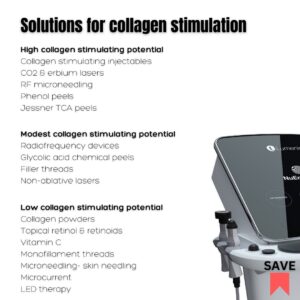
What are hyaluronic acid serums & how do they differ from HA based biostimulators?
Hyaluronic acid serums are incredible when used as moisturizers and humectants. You can easily purchase them online, at The Formulated, or from a clinic. These serums work by trapping water and delivering hydration to the outer layers of the skin.
On the other hand, HA injectables provide a deeper level of dermal hydration that cannot be achieved through regular skincare products alone. The name itself suggests that these injectables penetrate deep into the skin for optimal results.


